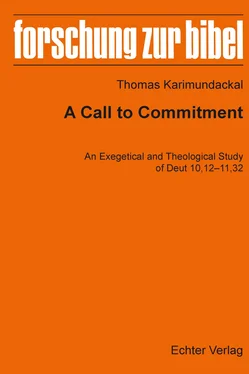7The only other occurrence of ועתה ישׂראל in Deuteronomy is in 4,1 where Moses begins a new didactic discourse by calling for the people’s attention. TALSTRA, Observations, 196, relates ועתה ישׂראל to the other imperative vocative pattern in 9,1 and 9,7 and shows that these verses mark a new structural beginning.
8Cf. Deut 3,23; 4,7-8.32-34; 5,25-26; 6, 20-25; 29,24; 30,12-13; 32,6.34; 33,29.
9V10 begins with the qal perfect עמדתי which is preceded by ואנכי for emphasis, cf. BDB § 659.
10This division also agrees with the view of the majority of biblical scholars who consider 9,1-10,11 a literary whole and Deut 10,12 signals the beginning of the final part of the parenesis in Deuteronomy (10,12-11,32), cf. LOHFINK, Hauptgebot, 219-220; OTTO, Deuteronomium, 1018; BRAULIK, Deuteronomium, 84; VEIJOLA, Deuteronomium, 244-245; NIELSON, Deuteronomium, 119-121; FINSTERBUSCH, Deuteronomium, 94-95; MCCONVILLE, Deuteronomy, 193-198; WEINFELD, Deuteronomy, 453-455; BRUEGGEMANN, Deuteronomy, 128-129; MAYES, Deuteronomy, 207; NELSON, Deuteronomy, 129-135; BOCK, Deuteronomy, 268. However, CRAIGIE, Deuteronomy, 201-211, considers 10,11-11,25 to be a literary whole, and according to him 10,11 “serves as a transition from the substance of the previous passage to the new emphasis of Moses’ address”, ibid., 203.
11For a detailed discussion of the various suggestions proposed for the chosen place, see MCCONVILLE, Time, 117-124.
12There is a certain ambiguity in the use of המקום in 12,3 as it raises the question whether it refers to a sanctuary or land. Deut 12,2 commands to the destruction of all המקמות of foreign worship and 12,3 continues this command of 12,2 to destroy their name from המקום. Naturally one would expect the plural המקמות in 12,3 instead of the singular המקום. Therefore it is logical to conclude that it may not be referring to the sanctuaries but to the land. For a similar discussion, cf. MCCONVILLE, Time, 131-137.
13The commands to make a ritual ceremony of blessing and curse on Mounts Gerizim and Ebal (11,29), and to observe all the statutes and judgments of the Lord (11,32) when they possess the land (11,31) make a smooth transition to the future orientation in ch.12.
14According to LOHFINK, Neubegrenzung, 249-52, the future indicated in the law code applies only to the period when Israel occupies the land. He substantiates this argument with the synonymous use of אדמה for ארץ in 12,1. In contrast to Lohfink, MCCONVILLE, Time, 126-130, thinks that law and life in the land are co-extensive since obedience to the Law is an imperative to live in the Promised Land, in relationship with Yhwh. PLÖGER, Deuteronomium, 61, tries to explain the pervasive future in the Law Code as eschatological. According to him, land as “Heilsgabe” is both present and eschatological because the land is given to Israel as a fulfilment of the promise given to their ancestors.
15The verbal instructions, such as ,(12,3) תגדעון ,תשׂרפון ,(12,2) תאבדון ,(12,1) תשׁמרון 12,8) תעשׂון ,(12,7) ושׂמחתם ,ואכלתם ,(12,6) והבאתם ,(12,5) תדרשׂו ,(12,4) תעשׂון) etc., are actions which are about to take place, and may continue for a shorter or longer time in the future. All these intended actions and instructions represent a sphere of future time or act in some way as conditional. V8-9 express this future notion in a subtle way as פה היום in 12,8 is contrasted with the idea of going over into the land in 12,9 (“you shall not act as we are acting here today … for you have not come into the rest …”). This is further substantiated with the conditional promise in v10-11. The imperfect with לא in 12,4 and 8 expresses the definite expectation that something will not happen, cf. GKC, § 1070.
16The details contained in the specific stipulation are varied and are focused on the religious, ceremonial and ethical dimensions of Israel’s Yhwh-centred existence in the Promised Land. This is sharply in contrast with the general stipulations in chs. 5-11 which are based on the love of Yhwh and love for Yhwh. On this distinction, cf. BALTZER, Covenant,10; CRAIGIE, Deuteronomy, 22-23.
17Cf. LOHFINK, Hauptgebot, 233; BRAULIK, Deuteronomium 1-16,17, 91; WEINFELD, Deuteronomy, 451.
18There are attempts among scholars to consider v31-32 as the beginning of the next textual unit. Authors like TIGAY, Deuteronomy, 118, ROFÉ, Strata, 222-23 and SEITZ, Studien, 38-40, view these verses as an introduction to the next unit, while WEINFELD, Deuteronomy, 453 and NELSON, Deuteronomy, 141, suggest that they can be regarded both as conclusion and introduction. Although the chiastic structure which is centred on the phrase 11,32) החקים והמשׁפטים and 12,1) helps one to consider v31-32 as introduction to the Law Code, cf. SEITZ, Studien, 40, this does not prevent one from considering it as a conclusion to the parenesis in 10,12-11-32, because the occurrence of the word pair החקים והמשׁפטים outside of chapter 4 functions as a boundary marker of various textual units (5,1; 11,32; 12,1 and 26,16). GEIGER, Gottesräume, 257 and MCCONVILLE, Deuteronomy, 207, understand v31-32 as transitional verses to the Law Code in chs. 12-26.
19Cf. GEIGER, Gottesräume, 257; cf. MCCONVILLE, Deuteronomy, 197.
20כי in 11,31 is traditionally rendered as causal as “for” by many scholars and translations, cf. CRAIGIE, Deuteronomy, 212; CHRISTENSEN, Deuteronomy 1-21:9, 226; KJV; RSV; NAS; JNB; ESV. Although WEINFELD, Deuteronomy 1-11, 453, translates כי with “for”, he also suggests that a temporal meaning is possible. SEITZ, Studien, 38-40, takes it as a conditional clause. Most contemporary scholars tend to take it as a temporal clause, cf. LOHFINK, Hauptgebot, 113-14, 233; ROFÉ, Strata, 222-23; TIGAY, Deuteronomy, 118; MCCONVILLE, Dueteronomy, 197; NELSON, Deuteronomy, 141; NIELSEN, Deuteronomium, 128.
21The other occurrences of the asyndetic אלה in Deuteronomy are in 1,1; 4,45 and 28,69, and all stand at the boundaries of a new narrative unit. The use of אלה in 12,1 is similar to that of the cleft structure pattern in 1,1; 4,45 and 28,69. The structural pattern, namely a nominal clause with a demonstrative pronoun followed by a relative clause containing a finite verb is characteristic of a cleft sentence: אלה/זה (this/these) + nominal clause + אשׁר (that) + verb, cf. CRYSTAL, Linguistics, 75. Though אלה is used in 27,12 its construction is different from the structural pattern mentioned above.
22DEROUCHIE, Call, 53.
23LOHFINK, Neubegrenzung, 244-48, makes a detailed study of its other occurrences in 4,45; 5,1; 5,31; 6,1 and 11,32 and shows that their function and linguistic character are different from 12,1. The superscript in 12,1 is unlike the other superscriptions in Deuteronomy (cf. 1,1; 4,44; 28,69; 33,1) as it literally stands out from them. While the superscriptions in 1,1; 4,44; 28,69 and 33,1 are placed in the narrator’s perspective, the superscript in 12,1 is uttered by Moses himself, cf. LOHFINK, Deuteronomium, 15-16. According to BRAULIK, Ausdrücke, 19, החקים והמשׁפטים forms an inclusion in the parenetic section (5-11) and the Law Code (12-26) in Deuteronomy, and as a “Struktursignal” it shows how the pareneses in 5-11 is related to the Law Code proper. For various theological and semantic senses of the phrase והמשׁפטים החקים in 12,1, cf. LOHFINK, Neubegrenzung, 229-256; idem., Dtn 12,1, 257-85; idem., Verständnis, 287-292. OTTO, Deuteronomium, 1018, takes 12,1 as epexegesis of חקים and משׁפטים in 11,32.
Читать дальше












